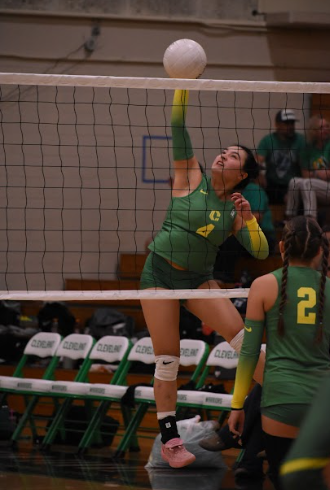Cleveland Involved In Petition To Sanction Boys Volleyball
Clarion photo Instagram: clevelandhsvball
The Cleveland boys volleyball team from the 2022 experimental season
Recently there has been a nationwide push to get boys high school volleyball sanctioned, with Oregon now included.
Ten different states have active petitions on Change.org advocating for sanctioning the sport, including one in Oregon, which launched on Sept. 6. The Oregon petition is pushing toward its goal of 2,500 signatures, with 1,629 as of Sept. 19.
As an unsanctioned sport, the only current access to boys volleyball is through expensive club teams, and Cleveland volleyball coach Sydney Hammond said that limits accessibility.
“Club volleyball in Oregon was mainly accessed by white participants for both girls and boys. However, in our experimental season last spring, about 50 percent of the player population were minorities. We need to sanction the sport to offer a low-cost alternative to club volleyball and increase accessibility,” said Hammond.
The experimental season offered a chance for students like Cleveland senior Merrick Woldridge to pursue boys volleyball.
“It’s been great seeing the support and growth of the team, even when it first started last year having a very healthy amount of people join. It was great to see,” said Woldridge. “Throughout the year watching more people come was amazing to see.”
Hammond and Woldridge both also mentioned accessibility at the college level. As boys volleyball grows at the high school level, the gap between men’s and women’s competition in college has remained huge. There are just 23 Division 1 men’s volleyball programs, compared to 334 for women’s, and through all the lower divisions, the gap remains in the hundreds, according to the NCSA college recruiting.
“It’s important for OSAA to sanction boys volleyball, because in the PPS district alone, there is such a big community of people who love the sport,” said Woldridge. “Having this sport sanctioned will allow all these kids looking for a future in volleyball to play beyond a high school setting.”
Hammond also specifically mentioned scholarships, saying, “there are so many college scholarships for men’s volleyball that go unclaimed. Sanctioning it at the high school level allows athletes another opportunity and sport to get a scholarship in.”
Women’s D1 teams have a scholarship cap of 12, while men’s teams are limited to 4.5. Hammond and Woldridge have reason to believe sanctioning would increase participation, and if that happened on the scale they expect, then not only could all of those scholarships be claimed, but the cap could be increased closer to the women’s one.
Oregon has represented the rapid nationwide growth of the sport from the experimental 2021 season alone.
“Nationally, boys volleyball saw a 4.5 percent increase with four more states officially adopting it. I think that brings the total up to about 30 states. In Oregon, we saw eight schools participate in our experimental season last year, and we are set to have almost 30 schools participate this year,” said Hammond.
From the start of that season, participation has been growing exponentially.
Woldridge also believes sanctioning is important to the US to catch up on an international scale, saying, “If volleyball gets sanctioned, I can see a very sharp increase in popularity of the sport of volleyball. It’s already pretty big in the US, but our European and Asian counterparts have a massive fan base for men’s volleyball. I feel like if it gets sanctioned, I could see a big spike in volleyball support.”
The next step in this process is a reading to the OSAA assembly in October, and in the meantime, the best way to help is to sign the petition “Sanction Boys High School Volleyball in Oregon” on Change.org.










